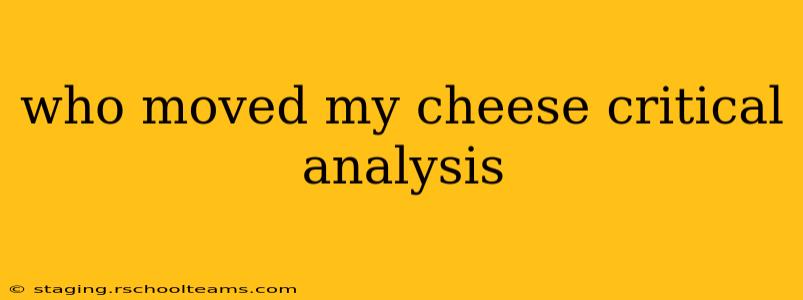Spencer Johnson's "Who Moved My Cheese?" is more than just a simple children's story; it's a parable that has resonated with millions, offering a surprisingly insightful look at change management and personal adaptation. While its simplicity might initially seem simplistic, a deeper critical analysis reveals layers of meaning and effectiveness, while also highlighting some limitations. This post will delve into a comprehensive analysis, exploring its strengths, weaknesses, and lasting impact.
What is "Who Moved My Cheese?" About?
The story follows four characters—two mice, Sniff and Scurry, and two "Littlepeople," Hem and Haw—navigating a maze in search of cheese, representing their goals and desires in life. The cheese supply is unexpectedly moved, forcing each character to react differently. Sniff and Scurry, driven by instinct, quickly adapt and find new cheese. Hem and Haw, however, initially resist change, clinging to their old ways until facing dire consequences. Haw ultimately learns to adapt, embracing change and finding even better cheese.
The Power of Simple Storytelling
One of the book's greatest strengths lies in its simplicity. The allegorical nature of the story makes it accessible to a wide audience, regardless of age or background. The characters are easily relatable, embodying common human responses to change: denial, fear, anger, and ultimately, acceptance. This simplicity is a powerful tool, allowing the core message—the importance of adapting to change—to resonate deeply.
Key Themes Explored in the Book
The book delves into several key themes critical to navigating the modern world:
The Inevitability of Change:
This is perhaps the most central theme. "Who Moved My Cheese?" forcefully emphasizes that change is constant and unavoidable. Ignoring this reality leads to stagnation and unhappiness.
Proactive vs. Reactive Approaches:
The contrasting behaviors of Sniff and Scurry versus Hem and Haw highlight the importance of a proactive approach to change. Those who anticipate change and adapt quickly are more likely to thrive.
Fear of the Unknown:
The Littlepeople's initial resistance stems from their fear of venturing into the unknown. The story underscores the necessity of overcoming this fear to embrace new opportunities.
The Importance of Letting Go:
Clinging to the past, to old ways of doing things, prevents growth and progress. Haw's eventual success comes from his willingness to let go of his attachment to the old cheese.
Adapting and Moving On:
The book's ultimate message revolves around adapting to change and continuously seeking new opportunities. The "better cheese" represents not just material gains but also personal growth and fulfillment.
Criticisms and Limitations
While "Who Moved My Cheese?" is undoubtedly influential, it's not without its criticisms:
Oversimplification:
Some critics argue that the story's simplicity oversimplifies the complexities of real-world change management. The nuances of organizational change, political shifts, and personal trauma are not fully addressed.
Lack of Depth:
The characters are archetypes rather than fully developed individuals. This lack of depth can limit the emotional impact for some readers.
Individualistic Focus:
The story primarily focuses on individual adaptation, potentially overlooking the systemic factors that contribute to change and the importance of collaborative approaches.
Who Moved My Cheese? and the "People Also Ask" Section
Let's address some frequently asked questions about this impactful book:
How can I apply "Who Moved My Cheese?" to my workplace?
The principles of adapting to change, anticipating shifts, and embracing new opportunities are highly relevant in the workplace. "Who Moved My Cheese?" provides a framework for navigating workplace restructuring, technological advancements, and shifts in market demands. Encourage proactive behavior, open communication, and a willingness to learn new skills.
Is "Who Moved My Cheese?" suitable for children?
While the book uses simple language and characters, its underlying message about change and adaptation can be beneficial for children. It teaches valuable life lessons about resilience and the importance of adjusting to new situations.
What are the main takeaways from "Who Moved My Cheese?"
The main takeaways are the inevitability of change, the importance of adapting quickly, the need to anticipate change, and the power of letting go of the past to embrace new possibilities.
What are the different types of cheese in "Who Moved My Cheese?"
The "cheese" in the story represents whatever one seeks in life – goals, jobs, relationships, or anything that brings happiness and fulfillment. The types of cheese are not specifically defined; rather, they are symbolic representations of different aspirations.
Is "Who Moved My Cheese?" just a simple motivational story?
While it is motivational, "Who Moved My Cheese?" offers a framework for navigating change that extends beyond mere inspiration. Its simplicity allows for a deeper exploration of personal responses to challenges. It encourages introspection and a proactive approach to life's inevitable shifts.
Conclusion
"Who Moved My Cheese?" remains a surprisingly powerful and relevant parable. Its simplicity is both its strength and its weakness. While it might lack the depth and complexity of more nuanced analyses of change, its accessibility and impactful message continue to resonate with readers across various backgrounds. Its value lies in its ability to provoke reflection and inspire action in the face of change—a lesson universally applicable in our ever-evolving world.
